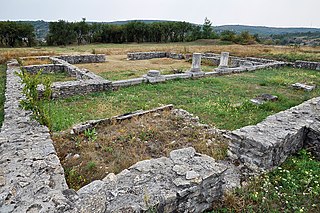
Apulon was a Dacian fortress city close to modern Alba Iulia, Romania. The Latin name of Apulum is derived. The exact location is believed by many archaeologists to be the Dacian fortifications on top of Piatra Craivii, Craiva, Cricău, about 20 km north of Alba-Iulia.

Porolissum was an ancient Roman city in Dacia. Established as a military fort in 106 during Trajan's Dacian Wars, the city quickly grew through trade with the native Dacians and became the capital of the province Dacia Porolissensis in 124. The site is one of the largest and best-preserved archaeological sites in modern-day Romania. It is 8 km away from the modern city of Zalău, in Moigrad-Porolissum village, Mirsid Commune, Sălaj County.

Sucidava was a Dacian and Daco-Roman city situated in Corabia, Romania, on the north bank of the Danube. It developed from the 270s AD and especially after the construction of Constantine's Bridge the northern side of which it protected.

The Limes Alutanus was a fortified eastern border of the ancient Roman province of Dacia built by the Roman emperor Hadrian to stop invasions and raids from the east.

Acidava (Acidaua) was a Dacian and later Roman town and fort on the Olt river near the lower Danube. The settlement's remains are located in today's Enoşeşti, Olt County, Oltenia, Romania.

Castra of Boroșneu Mare was a fort in the Roman province of Dacia in the 2nd and 3rd centuries AD. A contemporary settlement was also unearthed at the fort. Its ruins are located in Boroșneu Mare in Romania.

The castra of Buciumi was a fort in the Roman province of Dacia in the 2nd and 3rd centuries AD. Remains of the surrounding vicus were also unearthed. The castra's ruins are located in Buciumi, Romania.
The castra of Gherla was a fort in the Roman province of Dacia. An inscription unearthed at the site proves that the stone fortress was erected in 143 AD. In addition to the vicus at the fort, a nearby contemporary settlement and a Roman cemetery were also unearthed in Gherla (Romania). All these sites were abandoned in the 3rd century.

The castra of Hoghiz was a fort in the Roman province of Dacia. The fort was built in the 2nd century AD, on the left bank of the Olt River, at a place where a Dacian settlement existing already in the 2nd century BC was unearthed. The fort and the nearby village were abandoned in the 3rd century AD. The ruins of the castra are located in Hoghiz, Romania.

The castra of Olteni was a fort in the Roman province of Dacia. It was built in the 2nd century AD. The archaeological site yielded coins issued by the Roman emperors Titus Flavius Vespasianus, Domitian, Trajan, Antoninus Pius, Elagabal and Alexander Severus. The fort was abandoned in the 3rd century. It ruins are located in Olteni in commune Bodoc in Romania.

The castra of Orheiu Bistriței was a fort in the Roman province of Dacia. It was built in the 2nd century AD. Archaeological research also identified the nearby vicus. The castra and the nearby settlement were both abandoned in the 3rd century AD. The ruins of the fort are located in Orheiu Bistriței.

The castra of Aradul Nou was a fort in the Roman province of Dacia, located on the western side of the defensive line of forts, limes Daciae. It is situated near Arad, Romania.
The castra of Drumul Carului was a fort in the Roman province of Dacia near Moieciu, Romania.

Praetorium I (Copăceni) was a fort in the Roman province of Dacia near the present village of Copăceni, Racovița, Vâlcea, Romania. It was part of the Roman frontier system of the Limes Alutanus along the Olt (river). It was built in 138 and reinforced with two towers two years later.
The castra of Fâlfani was a fort built in the 2nd century AD in the Roman province of Dacia. It was part of the Roman frontier system of the Limes Transalutanus.

Although not unanimously accepted, the existence of the castra of Cristești in the Roman province of Dacia is substantiated by bricks and tiles bearing the name of a Roman military unit, the Ala I Gallorum et Bosporanorum. The lack of any other traces of the Roman fort may easily be due to its destruction by the Mureș River. At Cristeşti, a Roman settlement from the 2nd and 3rd centuries AD was unearthed which was an important center of potters.
The castra of Odorheiu Secuiesc was a fort built in the 1st century AD. A nearby contemporary settlement was also archeologically identified. The castra and the settlement were abandoned in the 3rd century. Their ruins are located in Odorheiu Secuiesc in Romania. At the same settlement, the ruins of a Roman tower can also be identified at Piatra Coţofană.
The Castra of Jac was a fort made of earth in the Roman province of Dacia. It was erected in the 2nd century AD. Not far from the fort, the remains of a previous fortification and of a Roman watchtower were unearthed. The fort and the watchtower were abandoned in the 3rd century. Traces of the castra can be identified on Citera Hill in Jac.

The castra of Bumbești-Jiu now known as Vârtop was a fort in the Roman province of Dacia. It is located 35 m west of the Târgu Jiu - Petroșani road, in Bumbești-Jiu (Romania). It defended and secured the entrance to the Jiului gorge and the Roman road from Bumbești through Porceni over the mountains, through the Vâlcan Pass to Sarmisegetuza.
The castra of Densuș was a fort in the Roman province of Dacia. It was built by a Dacian settlement which had been founded before the Roman conquest of Dacia in 106 AD and continued to exist under Roman rule. Neither the date of the erection of the fort, nor its abandonment by the Romans have been determined. Its ruins are situated in Densuș (Romania).












